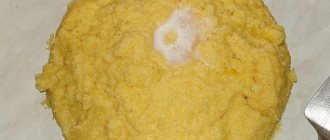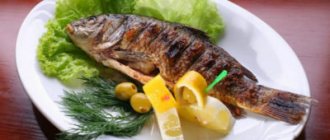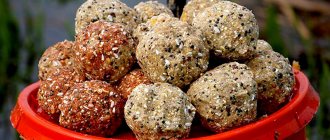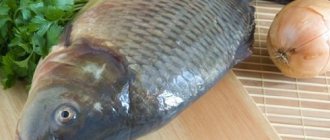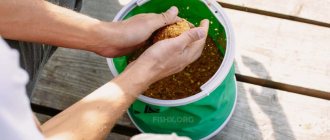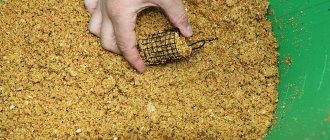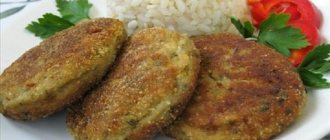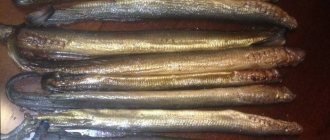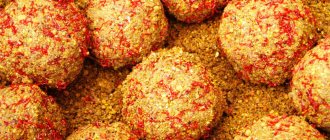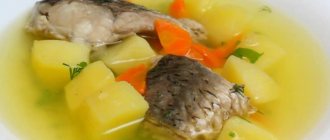Benefits of Salapin porridge
The key property of salapinka is that, in addition to finely dispersed components, one of the components is pearl barley, which is important for attracting large fish, since small ones are not able to swallow it.
Ready-made bait mixtures generally have a finely dispersed structure if they have an impressive odor. When it comes into contact with water, a cloud of turbidity appears, which arouses the fish's interest. But after it dissipates, the fish leaves the fishing spot if it doesn’t like the bait.
Salapin porridge performs the main tasks of bait, such as attracting fish and keeping it at the casting point, one hundred percent. In addition, it is able to provide long-term uninterrupted feeding, due to the fact that large components do not disintegrate immediately.
Other advantages of such porridge in comparison with ready-made bait:
- full control over the quality and freshness of ingredients;
- ease of preparation and availability of ingredients;
- ease of use, as you can take bait in any quantity.
Ingredients of classic Salapin porridge
You will need simple and inexpensive ingredients that are sold in any grocery store:
- pearl barley – 1 part;
- barley groats – 2 parts;
- corn grits – 3 parts;
- millet – 2 parts;
- water – 9 parts;
- vanilla sugar or vanillin – 2-5 grams;
- refined vegetable oil 1-3 tablespoons.
It is recommended to use homemade oil, which can be purchased in the market. It has a distinct smell of natural origin. The amount of butter and vanillin required is determined depending on the volume of the resulting porridge.
How to cook salapinka
I usually do not measure out grains in advance, but rather proceed slowly according to the recipe. First, take 4.5 parts of water, pour it into a saucepan, and put it on fire.
After the water has boiled, we pour 0.5 parts of pearl barley into it and reduce the heat. We need to wait until the water becomes cloudy and the pearl barley grains become transparent around the edges.
If this is the case, you need to add 1 part of millet and mix everything. After 2-3 minutes, add vanillin and oil and mix again. If you use seeds, they should be added at the end along with corn grits.
Now you can leave our porridge alone (do not stir, do not cover) and wait until the water is absorbed and holes appear on the surface of the porridge.
After waiting for this moment, drain the excess water (if there is any left) and add 1 part barley grits, 1.5 parts corn grits, and if you are using seeds, then 0.5 parts seeds.
Mix everything and leave to cool. The finished porridge should stick well and crumble easily, in general, like ready-made feeder bait. If the porridge turns out to be too sticky, it needs to be brought to working condition by adding corn grits.
It happens that, on the contrary, the porridge is too dry, in this case you need to add steamed rolled oats flakes to the mixture, again until it reaches the desired consistency. After this, you can put our bait into a bag and put it in the refrigerator.
Preparation
To properly prepare Salapin porridge, it is important to adhere to the following sequence of actions:
- Place a pan of water on the fire and heat to a boil;
- add pearl barley porridge, reduce heat to low and close the lid;
- cook for 20-30 minutes until half cooked, stirring from time to time and skimming off the foam. A sign of readiness is the appearance of a light rim along the edges of the grains;
- add millet, mix everything and continue cooking over low heat;
- after 5 minutes add vanilla sugar and pour in a little sunflower oil;
- turn off the heat at the moment when the millet has completely absorbed all the water and begins to boil;
- close the pan with a lid and leave the porridge to simmer for 30-40 minutes until characteristic wells appear;
- add corn and barley grits and mix thoroughly. If the pan is spacious, then it is easier to stir in it, otherwise it is better to use a separate container, such as a basin;
- During the time before fishing, the grains will swell a little.
Salapin porridge for crucian carp fishing
Those who catch bream on a feeder have heard about the “salapinka”. It is washed out of the feeder gradually, this is exactly what you need when fishing with a spring. Actually, the spring is the same feeder, only modified. We recommend using the Salapin porridge recipe for catching crucian carp. Our experts tried it and were satisfied. The basic recipe contains the following components:
- Pearl barley;
- Millet;
- Barley grits;
- Corn grits;
- Water;
- Unrefined sunflower oil;
- Vanillin.
Any container is suitable for the measuring unit. We will use a half-liter jar.
To prepare the “salapinka,” pour 1.5 cans of water into a saucepan and let it boil.
- Pour 0.5 cans of pearl barley into boiling water.
- We turn the fire to the lowest possible level and, under the lid, bring the pearl barley to a state where the grains swell and are completely cooked.
- Now it's time to add the millet.
- We take a full can of cereal, send it to the pearl barley, and cook further. At this stage, dry and liquid flavors are added - vanillin and sunflower oil. Vanillin - sachet, oil - 3 tbsp.
- When the porridge begins to “puff” and there is almost no water left in it, turn off the fire.
- Covered with a lid, the brew is infused for 5 - 7 minutes. During this time, the remaining water will be absorbed.
- Transfer to a larger saucepan, as we will be adding dry cereal. The classic recipe for Salapin porridge for crucian carp suggests that eggs and corn grits are placed equally - 1 can each.
- Mix everything, add dry cereal if necessary.
If the porridge is prepared for catching crucian carp with a spring, steamed oatmeal is added to it. To feed the point, rolled oats are not necessary. The consistency of homemade bait allows you to form balls and throw them into the fishing area, or use method feeders.
Additional components and flavors
The classic recipe for Salapin porridge is described above. But sometimes it is useful to change the recipe a little, because you need to feed the fish with what you catch. That is, if peas or wheat are used as bait, then they will also be useful for porridge. It’s just important not to overdo it. The percentage of auxiliary components should not be more than ten of the total volume of porridge. Also, do not forget that the groundbait should not be more attractive than the bait.
As a flavoring agent, vanilla can be replaced with other strong-smelling additives. In this case, you should choose the aroma that is able to attract the object of fishing and corresponds to the time of year.
In spring and late autumn, flavorings with the smell of anise, garlic, dill work excellently, and it is also useful to add bloodworms or finely chopped worms.
In the summer heat, the fish prefers sweet smells such as honey, strawberry, peach, banana or caramel.
Often, clay is taken as an auxiliary component from the reservoir in which fishing is carried out. As a result, the saturation of the fish will occur more slowly and the likelihood of catching a large specimen will increase.
Porridge made according to the described recipe can be used either separately or in combination with purchased bait.
Homeland and history of use of our food
You might think that the recipe for this porridge came to us from distant countries, but it turns out that it was created by our compatriot, Russian Dmitry Salapin. He is a professional fisherman and has visited many reservoirs in Russia and neighboring countries. As a fisherman, he became famous thanks to the Internet. He runs several blogs and also makes videos, but many know him by the name of his bait. This porridge was prepared as an effective dressing for the bait table for bream, but it turned out that it is suitable for fishing in the parking lot for any type of fish, except for predators.
The author wanted to prepare a simple, effective complementary food, using available ingredients that are present in almost everyone’s kitchen. The result exceeded most expectations. Amateur fishermen changed the porridge to bream depending on the regions and available ingredients. Therefore, the bait received several variations; let's talk about the basic one, proposed by Dmitry Salapin himself.
Where does Salapin porridge work?
Salapin porridge is equally effective both on the current and in ponds, lakes and reservoirs. For fishing in still water, the bait should be made more crumbly, and for the river - more viscous, so that it does not erode too quickly.
The consistency of the porridge can be changed on the shore of a pond without any problems. To do this, add water to the too crumbly bait or mix in steamed rolled oats, and in the opposite situation, add egg or corn flour. Naturally, after changing the composition of the bait, it is necessary to mix it.
The color of the porridge often significantly affects the fishing result. The resulting porridge can contrast greatly with the dark bottom. This problem can be solved using food coloring.
How Salapin porridge behaves under water
If the feeder porridge gets into the water, it should be slowly washed out of the feeder. To do this, you need to prepare complementary foods with a crumbly consistency. When you hit the bottom, some of the porridge should spill out, and the remainder should slowly disperse around the feeder. The large fraction usually remains at the feeding point, which attracts and retains trophy individuals.
For float fishing, you can add steamed rolled oats flakes to the main composition. Oatmeal will give the ingredients additional viscosity. Thus, the bait will easily roll into balls of the required diameter and slowly disintegrate into its constituent components. Before fishing in a stagnant body of water, you can prepare the balls in advance and put them in a plastic bag or container.
We recommend reading
How to cook porridge for bream to get a record catch Bream is an intelligent and cautious fish, which is almost impossible to catch without bait. To make food you need...
Bait methods
Salapinka works when fishing with a feeder, float rod and spring. When fishing on a feeder, the feeder is filled with porridge before casting. Complete washing of the porridge on the river occurs in a few minutes, depending on its consistency and the size of the feeder cell. The time between casts should not exceed five minutes, since feeder fishing is characterized by frequent casts.
It is advisable to use Salapin porridge when fishing with a spring in reservoirs with standing water or low currents. In a good current it washes out very quickly. By squeezing the feeder harder, you can slightly increase this time.
Fishing with a fly rod involves throwing compressed balls of porridge at the fishing point.
Despite the cheapness of Salapin porridge, the fish reacts very well to it, it is only important to prepare it correctly!
- Choosing a vibrating tail for pike perch
- Wobbler Megabass Flap Slap
- Silicone baits from AliExpress
- Jigs for winter fishing
Simple recipes for your favorite bream baits
We bring to your attention recipes for bream porridge depending on the time of year and type of reservoir.
The addition of animal components (maggots, worms, bloodworms) is a mandatory component of winter feeding of bream. This is due to the limited food supply. A large trophy will not miss the opportunity to enjoy such a delicacy.
For ponds with standing water
You need to prepare the following ingredients:
- ground coriander - on the tip of a teaspoon;
- bran – 300 g;
- breadcrumbs – 300 g;
- millet porridge – 300 g;
- peeled sunflower seeds (roasted) – 200 g.
It is recommended to use clay or soil from the fishing site as a binding component. We pre-wash the millet and cook over low heat for 15–20 minutes. It should be added to the bait when it has cooled down. The seeds need to be crushed. All components are combined and thoroughly mixed until a homogeneous consistency is obtained.
For summer fishing in bodies of water with currents
When fishing on rivers you need to prepare:
- breadcrumbs – 100 g;
- ground sunflower seeds (roasted) – 200 g;
- oatmeal – 200 g;
- coriander – 3 teaspoons;
- young peas or canned corn – 200 g.
Cook the cereal over low heat for 5 minutes. Let it cool. And only then mix it with the rest of the ingredients. Clay is added for viscosity.
For spring fishing
Preparation of bait is carried out with the addition of animal components. The recipe is as follows:
- rye bran – 100 g;
- feed bloodworm - 3 tbsp. spoons or matchbox;
- roasted sunflower seed cake – 100 g;
- millet – 100 g.
When adding cereals to the mixture, it is recommended to boil them. To get a viscous mixture you need to add clay, soil, sand from the reservoir where fishing is carried out.
For autumn fishing on the river
The best bait for bream in these conditions is made according to the following recipe:
- rye bran – 100 g;
- ground coriander – 1 teaspoon;
- wheat breadcrumbs – 100 g;
- bloodworms or maggots - 2 matchboxes;
- rice – 100 g;
- fresh unsalted lard – 50 g.
Rice should be cooked for 20–30 minutes over medium heat, stirring constantly. The prepared porridge is left to cool and only then added to the bait. Lard is cut into cubes measuring 5*5 mm. Clay is added for viscosity.
Some components can be replaced without compromising the quality of the bait. So, instead of millet, pearl barley is suitable. If there are no bloodworms, then you can take maggots or chopped worms. Breadcrumbs - barley, corn grits.
Cooking porridge from peas for fishing with a spring
When using springs to catch large specimens, it is necessary to prepare the bait of the required consistency so that it does not spill out ahead of time. Properly cooked pea porridge is an excellent option for such a feeder.
Peas are one of the favorite delicacies of bream in any form: whole or porridge. This component is considered to work at any time of the year.
Prepare in the following sequence:
- A glass of split yellow peas goes into a liter of water. Pour into a saucepan and place on low heat.
- As it boils, white foam will rise. You need to constantly remove it and stir the peas.
- When the foam begins to disappear little by little, increase the heat on the stove.
- Add ½ teaspoon of baking soda to the pan and stir quickly. This is necessary so that the peas boil faster and are soft.
- As soon as a homogeneous mass is formed in the container, add half a glass of millet.
- Boil the contents for 10 minutes and add 1 teaspoon of salt and sugar. Let it boil and remove from heat.
- For a pleasant aroma, you can add a little flour.
This interesting bait can be obtained from ordinary peas.
Cooking porridge on the feeder
Bait with large particles will not only lure bream to the fishing spot, but will also hold it for some time. At a time when small particles are sprayed throughout the water and will be eaten in a matter of seconds.
To make a high-quality feeder on the feeder, you must add coarse feed.
When fishing with a feeder, it is recommended to add:
- canned corn;
- chopped worm;
- steamed peas;
- boiled cereals (millet, pearl barley, rice);
- maggot;
- bloodworm.
To cook porridge correctly, you need to first rinse the cereal well, add water in a ratio of 1:2 (cereal/water) and cook over low heat, stirring constantly.
A unique recipe for Salapin porridge
The main feature of Salapin porridge is that all stages of preparation are carried out at home.
It received this name in honor of its creator, Dmitry Salapin. This is the favorite bait for bream among feeder fishing experts.
How to steam peas for fishing in a thermos
Step by step it looks like this:
- Fill a 5 liter pan with 1.5 liters of water. As soon as the water boils, add a glass of pearl barley.
- The fire is set to low. The barley is cooked until done.
- Add 300 g of millet to the cooked cereal. Mix thoroughly. Let it simmer for 5 minutes.
- Then add 2 tablespoons of sunflower oil and 1 packet of vanillin. Mix again.
- Cook over low heat until the millet is cooked. There should be no water left in the pan.
- Turn it off. Wrap with a towel for 20 minutes. We give the cereals time to absorb the remaining liquid and swell more.
- Finally, add 300 g of barley and corn grits to the pan. Mix.
Salapin porridge is ready. It should turn out to be plastic and compress in your hand without effort.
If the porridge is too liquid, add more dry cereal. Steamed oatmeal will save the mixture if it is too hard.
When using this bait in reservoirs with strong currents, it is recommended to squeeze the feeder tightly in your fist before casting so that the entire contents fly to the fishing spots.
